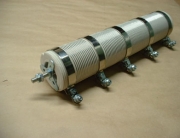23 May 2016. By definition, power resistors are designed to dissipate high power ratings (current times voltage across the resistor) at a nominated electrical resistance. This is often necessary when working with electrical circuits where significant voltage and / or electrical current are present. Ohms Law dictates that the power dissipated in a power resistor can be calculated as:
Power = Current squared x Electrical resistance or
Power – Current x Voltage dropped across the resistor
These are fundamental ways to determine the correct wattage of the power resistor required for a particular electrical application or circuit. The specification for power resistors not only includes the power rating, wattage and tolerance of the resistance winding, but also the required ‘package’ that the resistor comes in. Examples of different package styles include:
- Low profile ‘flat’ resistor package. An example is the FRW series resistor which is often selected when the physical space to mount the resistor is limited. It is available in different power ratings ranging from 20 watts to 75 watts
- Aluminium clad resistors. The GMR aluminium housed resistors are designed for applications required relatively high power ratings but a compact physical dimension for the resistor. The GMR series are available up to 350 watt rating.
- Tubular power resistors. Considered to be an ‘industry standard’ the tubular style power resistors have been manufactured for well over 60 years. The resistors are made by applying a resistance winding onto a ceramic former which allows for efficient heat dissipation. The coating applied to the finished resistor also allows high reliability operation at high temperatures.
Clearly, the selection of power resistors needs to take into account:
- the electrical circuit it is intended for
- the resistor power rating
- the physical packaging of the resistor
- the resistor tolerance and resistance
A selection guide for power resistors can be found here.

